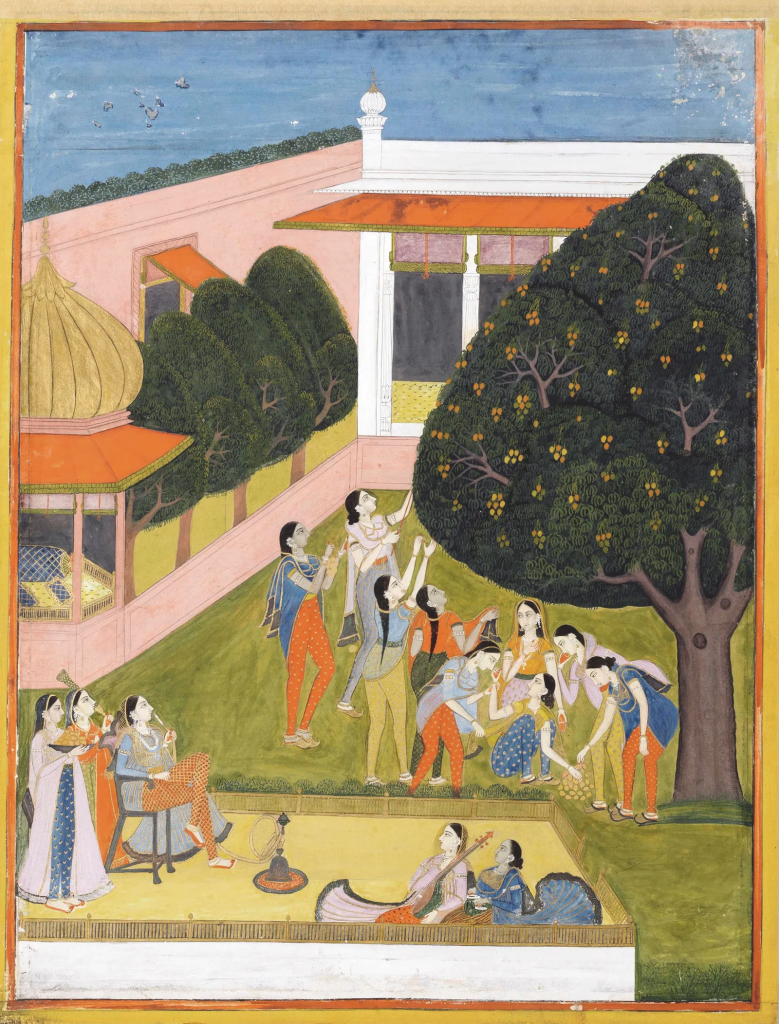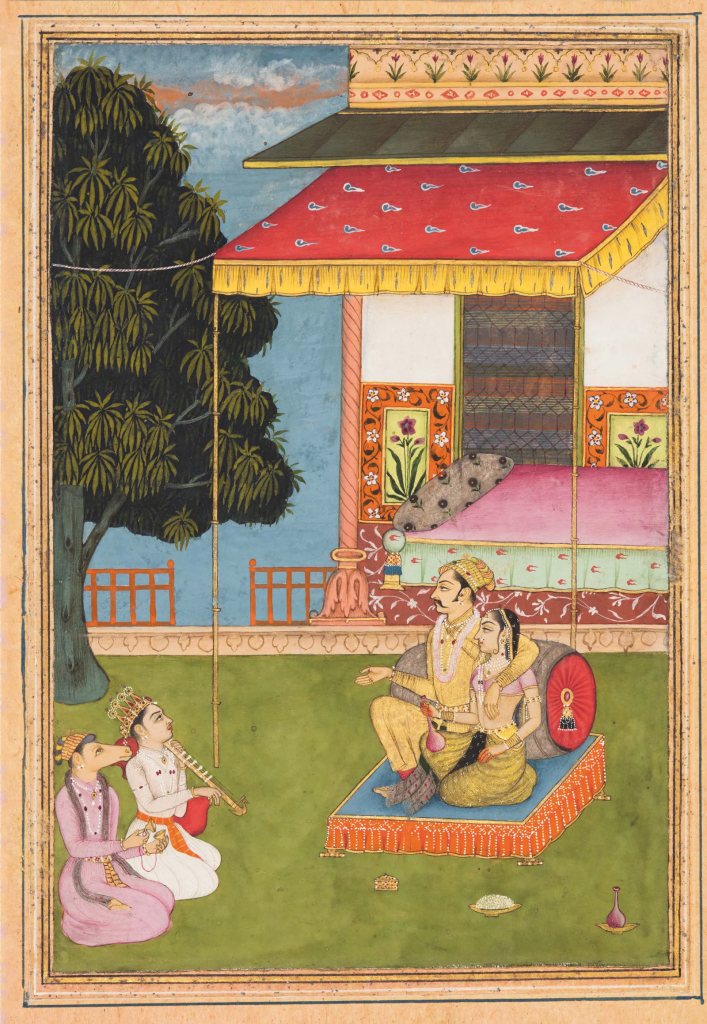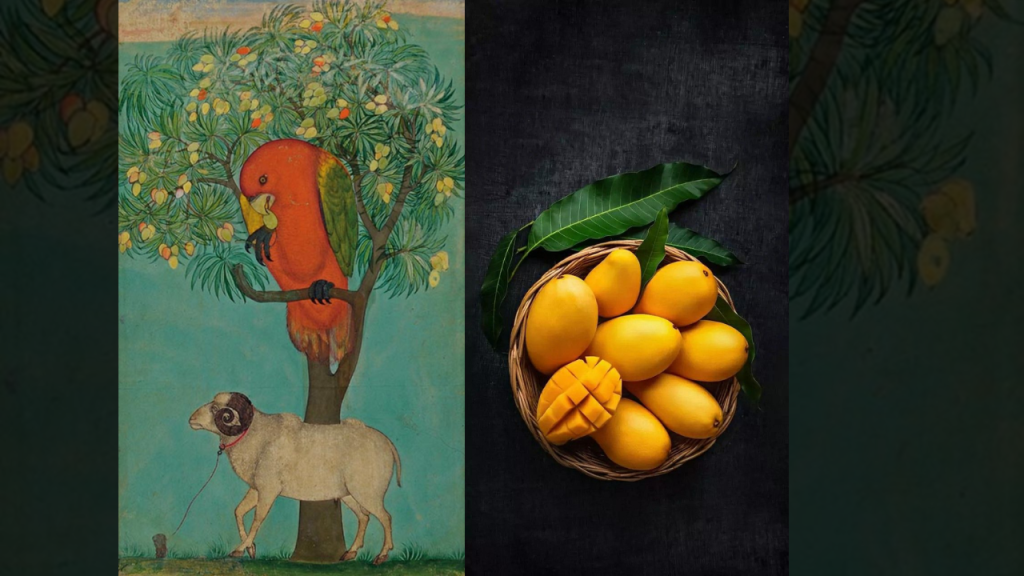Introduction
Revered as the “king of fruits,” mangoes are synonymous with the peak of summer’s bounty, a time when their ripe, golden hues adorn orchards across the land. But why this regal epithet? To uncover the deeper significance behind this title, we must delve into the annals of ancient texts, where the mango emerges not merely as a fruit but as a cultural icon steeped in symbolism & mythology. Beyond their literal sweetness, mangoes in ancient Indian texts serve as metaphors for the joys of life & the rewards of virtuous living. They are offered in rituals, celebrated in festivals, & coveted in the courts of kings. Their mention in texts like the Kamasutra even elevates them to the realm of aphrodisiacs, entwining their allure with the matrix of human desire & pleasure.

To underst& why mangoes reign as the king of fruits in India is to explore not only their botanical allure but also their cultural resonance across millennia. Let’s see through ancient Indian literature to uncover the layers of meaning & symbolism that have endowed the mango with its royal title, revealing a fruit that transcends its culinary delight to embody the very essence of summer’s bounty & the richness of Indian cultural heritage.
1. Puranas & Upapuranas
Mangoes are depicted in Puranic literature as offerings of spiritual significance, often ripe & luscious, symboliSing prosperity & spiritual fulfilment. They are seen as gifts from the gods, highlighting their celestial & paradisiacal attributes. In divine narratives within the Puranas, mangoes are enjoyed by gods & celestial beings, highlighting their celestial pleasure & association with abundance in both mortal & divine realms. In the Upapuranas, mangoes are prominently mentioned in rituals, festivals, & allegorical tales, elucidating their spiritual & cultural significance. Mangoes are not only associated with prosperity, fertility, & sensory delight but also play a crucial role in Hindu religious traditions, bridging the mundane with the sacred, enriching ancient India’s cultural mosaic.

At the forest’s edge, circa 1765, Lucknow, gouache and gold on paper, style of Hunhar II. The ripe mangoes ready to be plucked are a symbol of fertility and plenty, adding to the imagery of the young women frolicking in the river and the approaching rains, ready to nourish the land.| COURTESY: of The Cleveland Museum Of
2. Rigveda
The Rigveda, an ancient Indian scripture, depicts mangoes as symbols of pleasure & abundance, closely linked to the divine figure of Indra. Mangoes represent both physical enjoyment & spiritual fulfilment, with their sweetness & joy suggesting a connection between earthly delights & transcendent pleasures. Indra, the Vedic deity responsible for rainfall & agricultural prosperity, is often praised alongside references to mangoes, highlighting their significance in ensuring bountiful harvests & agricultural abundance. The Rigvedic hymns also highlight mangoes’ role in sustaining life & fostering prosperity, as they are not just fruits but also symbols of agricultural fertility & the rewards of virtuous living. Their inclusion in Vedic hymns reflects a holistic worldview where nature, divinity, & human existence are intertwined.

3. Ramayana
The Ramayana, a Hindu epic, depicts mango trees as integral parts of the lush gardens of Lanka, a kingdom ruled by the demon king Ravana. These trees symbolize exotic beauty, prosperity, & wealth, reflecting the opulence & luxurious lifestyle enjoyed by Ravana & his subjects. The presence of mango trees in Lanka’s gardens enhances the depiction of earthly paradises, where nature’s bounty coexists with human achievements. Mangoes in the Ramayana also reflect their cultural significance in ancient India, as they are revered as symbols of pleasure & abundance. They also contribute to the narrative depth by adding layers of symbolism & thematic resonance, evoke themes of temptation, desire, & the contrast between earthly indulgence & spiritual purity. Overall, the depiction of mango trees in the Ramayana enriches the epic’s imagery & thematic exploration.
4. Kamasutra
The Kamasutra, an ancient Indian text, depicts mangoes as a fruit of sensuality & aphrodisiac, enhancing the erotic experience. Mangoes are symbolized by their rich flavour & enticing aroma, enhancing intimate experiences & romantic encounters. They are also mentioned for their perceived aphrodisiac properties, stimulating desire & heightening sexual pleasure. This portrayal reflects broader cultural beliefs in ancient India, emphasising the holistic approach to sensuality & well-being. The text’s vivid imagery & poetic language enhance its narrative depth & thematic exploration. Mangoes also symbolize the pursuit of pleasure as a legitimate aspect of human experience, embodying the text’s philosophical stance on the integration of physical enjoyment with spiritual fulfilment. Overall, mangoes in the Kamasutra play a nuanced role as symbols of sensuality & aphrodisiac allure, contributing to the exploration of love, desire, & the art of living.

5. Kalidasa’s Work
Kalidasa, a renowned Sanskrit poet, uses mangoes as metaphors in his works, such as “Shakuntala” & “Meghaduta,” to evoke the sweetness, allure, & richness of nature. Mangoes are often compared to sweetness itself, symbolizing the pleasures of life & the earthly delights. They also symbolize natural beauty & abundance, reflecting the poet’s keen observation of the natural world. Mangoes also represent fertility & agricultural abundance, highlighting the harmonious relationship between humanity & the natural environment. They also hold cultural & social significance, often associated with festivities & royal feasts. Kalidasa’s poetic imagination & symbolic depth are evident in his use of mangoes as botanical elements & vehicles for exploring complex themes like love, longing, & the passage of time. His evocative verses cement mangoes as enduring symbols in classical Sanskrit literature. He writes, ” You know, Little Bee, that when the Cuckoo sees the Mango-Blossom, she becomes very excited and goes bonkers.”( feature Image).
Conclusion
Numerous songs and tales have referenced the romantic affinity between the cuckoo and the mango. This mangoes are referred to as “Fakhr-e-Gulshan,” or the glory of the Garden, by Amir Khusrau.
SAKAL BAN PHOOL RAHI SARSON
AMBVA PHOOTEY, TESU PHULE,
KOEL BOLEY DAR DAR,
GORI KARAT SHINGAR
Every field is filled with mustard flowers, mango buds burst open, flowers bloom, There is a cuckoo singing from every limb. The damsel wears cosmetics.
Mangoes acquire their regal reputation as the “king of fruits” in the rich tradition of Indian literature by means of a patchwork of cultural resonance & metaphorical depth. Mangoes represent more than just seasonal plenty in ancient literature like the Rigveda, Ramayana, Kamasutra, and works by Kalidasa; they also represent themes of pleasure, prosperity, and spiritual contentment. Mangoes transcend beyond their botanical identity to become symbols of cultural legacy and poetic inspiration. They are revered as offerings to gods in Puranic literature and shown in lush gardens of epic kingdoms. Their ongoing significance in moulding India’s cultural and spiritual landscape is seen in their being coveted for their aphrodisiac attraction, venerated in royal courts, and celebrated for their sweetness in ceremonies.
Feature Image: Left: “A PARROT PERCHED ON A MANGO TREE, A RAM TETHERED BELOW “, FROM GOLCONDA (1630-70), COLLECTION OF THE JAGDISH AND KAMLA MITTAL MUSEUM OF ART, HYDERABAD |
References
- Kadambari by Banabhatta. Translated by Gwendolyn Layne. Penguin Classics, 2020.
- Sharma, Rakesh Mohan. “The Mango in Indian Literature and Culture.” Indian Literature, vol. 42, no. 3, 1998, pp. 143-157. Provides an analysis of the mango’s representation in Indian literary texts across different languages.
- Mukherjee, Meenakshi. “Sensuous and Symbolic: The Mango in Indian Literature.” Journal of South Asian Literature, vol. 25, no. 2, 1990, pp. 91-105. Discusses the sensual and
- Britannica – Mango | Description, History, Cultivation, & Facts
- ResearchGate – Mangifera Indica (Mango)
- Padhega India – Mangifera indica: A Biography of the Mango
- “The Oxford Anthology of Indian Wildlife.” Edited by Sálim Ali and Ramachandra Guha, Oxford University Press, 1999. Includes poems and prose on mangoes and wildlife in India.
- Patel, Devang. “Symbolism of Mango in Indian Literature: A Study.” PhD thesis, University of Delhi, 2015. A comprehensive study on the symbolism and representation of mangoes in Indian literature.





